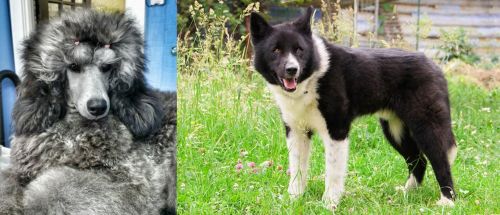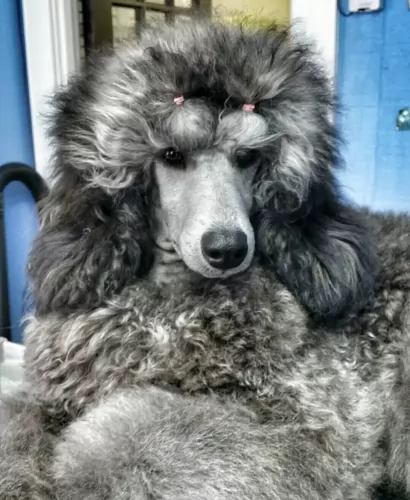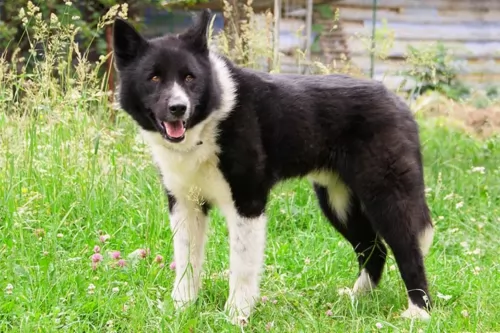 MyDogBreeds
MyDogBreeds Standard Poodle is originated from Germany but Karelian Bear Dog is originated from Finland. Standard Poodle may grow 20 cm / 7 inches shorter than Karelian Bear Dog. Both Standard Poodle and Karelian Bear Dog are having almost same weight. Standard Poodle may live 3 years more than Karelian Bear Dog. Both Standard Poodle and Karelian Bear Dog has same litter size. Both Standard Poodle and Karelian Bear Dog requires Moderate maintenance.
Standard Poodle is originated from Germany but Karelian Bear Dog is originated from Finland. Standard Poodle may grow 20 cm / 7 inches shorter than Karelian Bear Dog. Both Standard Poodle and Karelian Bear Dog are having almost same weight. Standard Poodle may live 3 years more than Karelian Bear Dog. Both Standard Poodle and Karelian Bear Dog has same litter size. Both Standard Poodle and Karelian Bear Dog requires Moderate maintenance.
 The Poodle is the national dog of France, and there they are known as the duck dog. The breed actually originated as a duck hunter in Germany. It was known as ‘Pudelin’ which means splashing in water.
The Poodle is the national dog of France, and there they are known as the duck dog. The breed actually originated as a duck hunter in Germany. It was known as ‘Pudelin’ which means splashing in water.
The dog has always had a crisp, curly coat to protect it from the elements. It is classified as a non-sporting dog. Soon the French became aware of what a fine dog it was and it became sought after among the elite in France.
It has been known for at least 400 years. While it is still not sure precisely from which country it comes, the poodle is a descendant of the French Water Dog which is now extinct.
 The Karelian Bear Dog is a Finnish Spitz-type dog who is regarded as a national treasure in the country. They have always been noted for their hunting skills, and because the dog has been found in ancient Viking graves you can assume it is an ancient breed.
The Karelian Bear Dog is a Finnish Spitz-type dog who is regarded as a national treasure in the country. They have always been noted for their hunting skills, and because the dog has been found in ancient Viking graves you can assume it is an ancient breed.
In fact the ancestry of the dog can be traced to neolithic times, when dogs followed human settlers to regions of Scandinavia and Europe.The American Kennel Club does not fully recognize the Karelian Bear Dog. It is however included in their Foundation Stock Service.
 The Standard Poodle is a medium-sized dog that stands between 35 and 40cm in height and weighs between 20 - 27 kg. The coat of the standard poodle is curly and medium length and it comes in a range of different colors – black, brown, cream, apricot or white.
The Standard Poodle is a medium-sized dog that stands between 35 and 40cm in height and weighs between 20 - 27 kg. The coat of the standard poodle is curly and medium length and it comes in a range of different colors – black, brown, cream, apricot or white.
The ears are medium shaped and floppy and the tail is most times docked to half its length. The muzzle is fairly long and the eyes are brown and alert.
Standard Poodles are full of the joys of living and they are friendly, fun, playful dogs. They love playing games with the children and they make excellent family dogs.
He is quite feisty and stubborn and will require training and socialization. He is smart and is in fact, one of the most trainable of all the dog breeds.
They can adapt to life in the city or the countryside but he will need to be exercised wherever he is. The Standard Poodle isn’t aggressive but he can still make a good watchdog.
 Standing at between 54–60cm in height and weighing roughly 20–23 kg, the medium sized Karelian Bear Dog has a beautiful shiny coat. The outercoat is shortish, straight and dense and the undercoat is soft and thick.
Standing at between 54–60cm in height and weighing roughly 20–23 kg, the medium sized Karelian Bear Dog has a beautiful shiny coat. The outercoat is shortish, straight and dense and the undercoat is soft and thick.
The color of the coat is black with white markings. The dog has a bushy tail which curls in a circle over the back and the tail’s end is white. The ears of the dog are small and erect while the small eyes are intense.
It is best to have your Karelian Bear dog trained and socialized as he can tend to be aggressive towards other pets in the house, and even towards people he isn't familiar with. The owner of these dogs must be firm and fair with training as the Karelian is a strong-willed dog.
He is devoted to his human owners while being somewhat aloof and unfriendly with strangers. They are very territorial.
He is a very social dog and just loves spending time outdoors with his family. He is also good with children in the home as he is a playful dog.He is a dog who is going to require a lot of space to use up his energy. He needs a lot of mental and physical stimulation, as in the past he has always had a lot of work to do, and just loves being active. He is a confident, brave dog who takes his job as family protector seriously.
 Poodles are clever, easy to train and capable of living well in the city or in the countryside.
Poodles are clever, easy to train and capable of living well in the city or in the countryside.
They’re adaptable dogs too which makes them excellent family pets. They’re active and social so when you bring one into your home, you’re going to know he is there.
He wants to be involved in every aspect of your life, bonding with all members of the family, loving to spend time with each one.
He is an all-rounder and will also be a great watchdog. Loving and loyal, the Standard Poodle is ready to become your ideal pet and companion.
 Your energetic Karelian Bear Dog isn’t recommendeded for life in the city in a small garden. He needs a large garden or farm where he can run far and wide.
Your energetic Karelian Bear Dog isn’t recommendeded for life in the city in a small garden. He needs a large garden or farm where he can run far and wide.
Exercising him will be an important part if you own one of these dogs. He is a social, friendly, active family pet who happens to make a good watchdog too.
Make sure you have your Karelian Bear Dog trained and socialized and he’ll make you a wonderful friend and pet.
 The Standard Poodle doesn’t have many health issues to worry about and he can live to a ripe old age of 15 or so if he is looked after well.
The Standard Poodle doesn’t have many health issues to worry about and he can live to a ripe old age of 15 or so if he is looked after well.
However, he can succumb to some of the common dog diseases there are – eye problems, skin allergies, bloat and ear infections.
Allergies in dogs can be caused by pollen, insects, food, and medicines. These allergies can all cause terrible itching, scratching, watery eyes, skin inflammation, and pain.
The ears, underarms, groin and around the eyes are often affected. It can make your pet most miserable. Your dog will have to get to the vet to relieve him of his discomfort and the vet will want a medical history to find out what is causing the problem.
 The Karelian Bear Dog can reach 10 to 12 years of age with good care, but just like with other dog breeds, he can be prone to certain health problems such as eye and dental problems as well as hip dysplasia.
The Karelian Bear Dog can reach 10 to 12 years of age with good care, but just like with other dog breeds, he can be prone to certain health problems such as eye and dental problems as well as hip dysplasia.
Many people don’t realize that dental problems are far more serious than what they imagine. An offensive breath can be the first warning sign of tooth decay with your canine friend.
There are other problems that can develop orally for your dog and these include inflammation of the gums, swollen gums and mouth tumors. You need to brush your pet’s teeth but also see to it that he goes for regular dental check-ups at the vet.
 The Standard Poodle will require regular brushing even though it is a low- or non-shedding breed. The curls can become matted. Some poodle owners choose to have their poodles professionally groomed and clipped.
The Standard Poodle will require regular brushing even though it is a low- or non-shedding breed. The curls can become matted. Some poodle owners choose to have their poodles professionally groomed and clipped.
The nails will need to be trimmed.
The teeth will also need to be checked if the dog will allow you to look inside his mouth. A bad, oozing tooth can cause all kinds of medical problems.
Because of the floppy ears, check inside the ears for dirt and wax buildup and signs of redness and a possible ear infection. If you don’t like to probe inside your dog’s ears or mouth, professional dog groomers will do this for you.
Your poodle is an active dog and he will need regular daily exercise. Chase him on the lawn, throw a ball for him, hide away from him and let him find you. He will also love daily walks.
Just like with any other dog, your Standard Poodle needs good, nutritional food to remain healthy. Some of the commercially manufactured dog foods you get are bad for a dog as they don’t have natural ingredients and are devoid of vitamins and minerals.
They’re certainly a convenient way to feed a dog, but try and go for the ones that are wholesome for your pet.
Home-made food such as boiled chicken, brown rice and vegetables is a good choice as it is healthy and won’t cause your dog to battle with digestive problems. Avoid spicy, exotic foods and things such as popcorn, onion, peanuts, and chocolate.
Make sure your Standard Poodle always has a bowl of fresh, cool water available.
 There are many people who just keep a dog for watchdog purposes and fail to make the pet a proper family member by meeting its physical and emotional needs.
There are many people who just keep a dog for watchdog purposes and fail to make the pet a proper family member by meeting its physical and emotional needs.
Caring for a dog means providing nutritious food and clean drinking water, seeing that he has a warm, dry place to sleep, providing the dog with exercise and ensuring the dog is healthy and content.
Caring for a dog is a big responsibility, and you have to think carefully before you bring a dog into your home and life.
You need to be careful with the food you select for your pet. If you’re feeding him a commercially manufactured food, you need to make sure to read the label and make sure the top ingredients are meat and not meat by-products. If this is something you’ve never thought about, ask your veterinarian for food recommendations.
Speaking of veterinarians, make sure you have a reliable, reputable vet you can call on. At some time or other your pet may get sick and then you want to have the name of a reliable vet in your contacts list on your cell phone. Sometimes your pet can become suddenly sick where he will need immediate, emergency help from the vet.
Just like you look after yourself, you need to look after your pet by brushing him, checking him for fleas, ticks and worms and keeping an eye on his eyes, ears, teeth and general health.